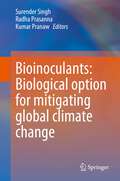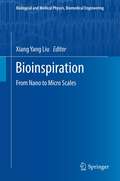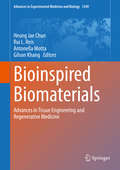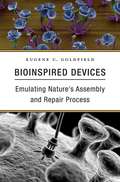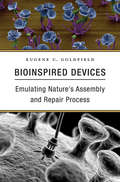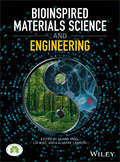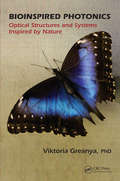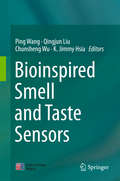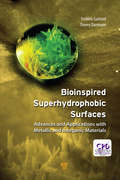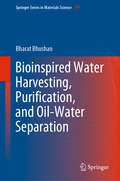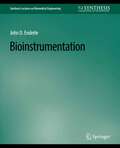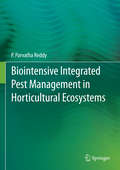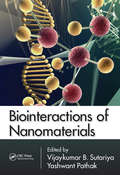- Table View
- List View
Bioinoculants: Biological Option for Mitigating global Climate Change
by Surender Singh Radha Prasanna Kumar PranawThis edited book covers various bioinoculants for sustainable crop production under the changing global climate. The book envisages a compilation of articles relevant to the current status of production and use of novel microbial inoculants for different crops and highlights their role in mitigating global climate challenges. These include nutrient deficiencies, salinity, drought, and emerging pathogens. In addition, success stories and commercialization aspects are also discussed. Growing environmental concerns related to climate change can potentially decrease the global yield capacity of agricultural systems. Agricultural productivity is severely affected by major biotic and abiotic factors. The phytomicrobiome plays a critical role in the survival of the holobiont, particularly for plants growing in extreme environments. The use of microbial-based agricultural inputs has a long history, beginning with a broad-scale rhizobial inoculation of legumes in the early twentieth century. Microbial inoculants are considered one of the best and most effective strategies for sustainable agriculture under climate change, and a viable solution to meet the twin challenges of global food security and environmental sustainability. It is therefore imperative to understand the current status and development in the area of bioinoculants from a global perspective. The chapter’s focus would be on major agro-ecologies, covering all major crops across the globe, along with the commercialization status of different bioinoculants in different countries The book caters to the needs of the students, faculty, policymakers, and researchers working in the area of microbiology, biotechnology, environmental sciences, and botany.
Bioinspiration: From Nano to Micro Scales (Biological and Medical Physics, Biomedical Engineering)
by Xiang Yang LiuMethods in bioinspiration and biomimicking have been around for a long time. However, due to current advances in modern physical, biological sciences, and technologies, our understanding of the methods have evolved to a new level. This is due not only to the identification of mysterious and fascinating phenomena but also to the understandings of the correlation between the structural factors and the performance based on the latest theoretical, modeling, and experimental technologies. Bioinspiration: From Nano to Micro Scale provides readers with a broad view of the frontiers of research in the area of bioinspiration from the nano to macroscopic scales, particularly in the areas of biomineralization, antifreeze protein, and antifreeze effect. It also covers such methods as the lotus effect and superhydrophobicity, structural colors in animal kingdom and beyond, as well as behavior in ion channels. A number of international experts in related fields have contributed to this book, which offers a comprehensive and synergistic look into challenging issues such as theoretical modeling, advanced surface probing, and fabrication. The book also provides a link to the engineering of novel advanced materials playing an important role in advancing technologies in various fields.
Bioinspired and Green Synthesis of Nanostructures: A Sustainable Approach
by Mousumi Sen Monalisa MukherjeeBIOINSPIRED AND GREEN SYNTHESIS OF NANOSTRUCTURES This unique book details various ways to synthesize advanced nanostructures using green methods, explores the design and development of sustainable advanced nanostructures, and discusses the antimicrobial and antiviral applications. The future of the world depends on immediately investing our time and effort in advancing ideas on ways to restrict the use of hazardous chemicals, thereby arresting further environmental degradation. To achieve this goal, nanotechnology has been an indispensable arena that has extended its wings into every aspect of modernization. For example, green synthetic protocols are being extensively researched to inhibit the harmful effects of chemical residues and reduce chemical wastes. This involves the study of nanotechnology for artful engineering at the molecular level across multiple disciplines. In recent years, nanotechnology has ventured away from the confines of the laboratory and has been able to conquer new domains to help us live better lives. Bioinspired and Green Synthesis of Nanostructures focuses on the recent developments and novel applications of bioinspired and biomimetic nanostructures as functionally advanced biomolecules with huge prospects for research, development, and engineering industries. It provides detailed coverage of the chemistry of each major class of synthesis of bioinspired nanostructures and their multiple functionalities. In addition, it reviews the new research results currently being introduced and analyzes the various green synthetic approaches for developing nanostructures, their distinctive characteristics, and their applications. The book provides readers with an understanding of the recent data, as well as various strategies for designing and developing advanced nanostructures using a greener approach. Audience The core audience of this book include materials scientists, nanoscientists, nanotechnologists, chemical and biological engineers, biochemists and biotechnologists. Industry process engineers and scientists working in nanomaterial synthesis will find this book extremely valuable.
Bioinspired and Green Synthesis of Nanostructures: A Sustainable Approach
by Mousumi Sen Monalisa MukherjeeBIOINSPIRED AND GREEN SYNTHESIS OF NANOSTRUCTURES This unique book details various ways to synthesize advanced nanostructures using green methods, explores the design and development of sustainable advanced nanostructures, and discusses the antimicrobial and antiviral applications. The future of the world depends on immediately investing our time and effort in advancing ideas on ways to restrict the use of hazardous chemicals, thereby arresting further environmental degradation. To achieve this goal, nanotechnology has been an indispensable arena that has extended its wings into every aspect of modernization. For example, green synthetic protocols are being extensively researched to inhibit the harmful effects of chemical residues and reduce chemical wastes. This involves the study of nanotechnology for artful engineering at the molecular level across multiple disciplines. In recent years, nanotechnology has ventured away from the confines of the laboratory and has been able to conquer new domains to help us live better lives. Bioinspired and Green Synthesis of Nanostructures focuses on the recent developments and novel applications of bioinspired and biomimetic nanostructures as functionally advanced biomolecules with huge prospects for research, development, and engineering industries. It provides detailed coverage of the chemistry of each major class of synthesis of bioinspired nanostructures and their multiple functionalities. In addition, it reviews the new research results currently being introduced and analyzes the various green synthetic approaches for developing nanostructures, their distinctive characteristics, and their applications. The book provides readers with an understanding of the recent data, as well as various strategies for designing and developing advanced nanostructures using a greener approach. Audience The core audience of this book include materials scientists, nanoscientists, nanotechnologists, chemical and biological engineers, biochemists and biotechnologists. Industry process engineers and scientists working in nanomaterial synthesis will find this book extremely valuable.
Bioinspired Approaches for Human-Centric Technologies
by Roberto CingolaniThe present book discusses topics related to research and development of materials and devices at nanoscale size and their respective application in medicine and biomedicine.The individual chapters give a detailed state of the art overview to the distinct topic. Apparently disconnected fields - life sciences, biomedicine, chemistry, physics, medicine and engineering - will be bridged with a highly interdisciplinary view onto each subject.
Bioinspired Biomaterials: Advances in Tissue Engineering and Regenerative Medicine (Advances in Experimental Medicine and Biology #1249)
by Rui L. Reis Heung Jae Chun Gilson Khang Antonella MottaThis book is the first of two volumes that together offer a comprehensive account of cutting-edge advances in the development of biomaterials for use within tissue engineering and regenerative medicine. Topics addressed in this volume, which is devoted to bioinspired biomaterials, range from novel biomaterials for regenerative medicine through to emerging enabling technologies with applications in, for example, drug delivery, maternal–fetal medicine, peripheral nerve repair and regeneration, and brain tumor therapy. New bioinspired hydrogels receive detailed attention in the book, and a further focus is the use of bioinspired biomaterials in the regulation of stem cell fate. Here the coverage includes the role of scaffolds in cartilage regeneration, the bioapplication of inorganic nanomaterials in tissue engineering, and guidance of cell migration to improve tissue regeneration. The authors are recognized experts in the interdisciplinary field of regenerative medicine and the book will be of value for all with an interest in regenerative medicine based on biomaterials.
Bioinspired Devices: Emulating Nature’s Assembly and Repair Process
by Eugene C. GoldfieldEugene Goldfield lays out principles of engineering found in the natural world, with a focus on how components of coordinated structures organize themselves into autonomous functional systems. This self-organizing capacity is one of many qualities which can be harnessed to design technologies that can interact seamlessly with human bodies.
Bioinspired Devices: Emulating Nature’s Assembly and Repair Process
by Eugene C. GoldfieldEugene Goldfield lays out principles of engineering found in the natural world, with a focus on how components of coordinated structures organize themselves into autonomous functional systems. This self-organizing capacity is one of many qualities which can be harnessed to design technologies that can interact seamlessly with human bodies.
Bioinspired Engineering of Thermal Materials
by Tao DengA comprehensive overview and summary of recent achievements and the latest trends in bioinspired thermal materials. Following an introduction to different thermal materials and their effective heat transfer to other materials, the text discusses heat detection materials that are inspired by biological systems, such as fire beetles and butterflies. There then follow descriptions of materials with thermal management functionality, including those for evaporation and condensation, heat transfer and thermal insulation materials, as modeled on snake skins, polar bears and fire-resistant trees. A discussion of thermoresponsive materials with thermally switchable surfaces and controllable nanochannels as well as those with high thermal conductivity and piezoelectric sensors is rounded off by a look toward future trends in the bioinspired engineering of thermal materials. Straightforward and well structured, this is an essential reference for newcomers as well as experienced researchers in this exciting field.
Bioinspired Engineering of Thermal Materials
by Tao DengA comprehensive overview and summary of recent achievements and the latest trends in bioinspired thermal materials. Following an introduction to different thermal materials and their effective heat transfer to other materials, the text discusses heat detection materials that are inspired by biological systems, such as fire beetles and butterflies. There then follow descriptions of materials with thermal management functionality, including those for evaporation and condensation, heat transfer and thermal insulation materials, as modeled on snake skins, polar bears and fire-resistant trees. A discussion of thermoresponsive materials with thermally switchable surfaces and controllable nanochannels as well as those with high thermal conductivity and piezoelectric sensors is rounded off by a look toward future trends in the bioinspired engineering of thermal materials. Straightforward and well structured, this is an essential reference for newcomers as well as experienced researchers in this exciting field.
Bioinspired Materials and Metamaterials: A New Look at the Materials Science (Emerging Materials and Technologies)
by Edward BormashenkoDevelopment of bioinspired materials and metamaterials has changed the philosophy of materials engineering and opened new technological possibilities, as they demonstrate properties that are not found in naturally occurring materials. This book examines advances in these emerging materials classes and investigates how their tailor-engineered properties, such as specific surface energy or refraction index, enable the design of devices and ultimately the ability to solve complex societal problems that are, in principle, impossible with traditional materials.The aim of this book is to survey the scientific foundations of the design and properties of bioinspired materials and metamaterials and the way they enter engineering applications. Introduces the physico-chemical foundations, theoretical groundings, and main equations of biomimetic and metamaterials science Describes how to develop and design these advanced materials and their applications Features end-of-chapter problems to help readers apply the principles Surveys achievements including metamaterials cloaking and the negative mass effect Emphasizes ecological aspects of materials science The text is intended for materials engineering students who have completed courses in general physics, chemistry, and calculus, as well as researchers in materials science and engineering.
Bioinspired Materials and Metamaterials: A New Look at the Materials Science (Emerging Materials and Technologies)
by Edward BormashenkoDevelopment of bioinspired materials and metamaterials has changed the philosophy of materials engineering and opened new technological possibilities, as they demonstrate properties that are not found in naturally occurring materials. This book examines advances in these emerging materials classes and investigates how their tailor-engineered properties, such as specific surface energy or refraction index, enable the design of devices and ultimately the ability to solve complex societal problems that are, in principle, impossible with traditional materials.The aim of this book is to survey the scientific foundations of the design and properties of bioinspired materials and metamaterials and the way they enter engineering applications. Introduces the physico-chemical foundations, theoretical groundings, and main equations of biomimetic and metamaterials science Describes how to develop and design these advanced materials and their applications Features end-of-chapter problems to help readers apply the principles Surveys achievements including metamaterials cloaking and the negative mass effect Emphasizes ecological aspects of materials science The text is intended for materials engineering students who have completed courses in general physics, chemistry, and calculus, as well as researchers in materials science and engineering.
Bioinspired Materials Science and Engineering
by Guang Yang Lin Xiao Lallepak LamboniAn authoritative introduction to the science and engineering of bioinspired materials Bioinspired Materials Science and Engineering offers a comprehensive view of the science and engineering of bioinspired materials and includes a discussion of biofabrication approaches and applications of bioinspired materials as they are fed back to nature in the guise of biomaterials. The authors also review some biological compounds and shows how they can be useful in the engineering of bioinspired materials. With contributions from noted experts in the field, this comprehensive resource considers biofabrication, biomacromolecules, and biomaterials. The authors illustrate the bioinspiration process from materials design and conception to application of bioinspired materials. In addition, the text presents the multidisciplinary aspect of the concept, and contains a typical example of how knowledge is acquired from nature, and how in turn this information contributes to biological sciences, with an accent on biomedical applications. This important resource: Offers an introduction to the science and engineering principles for the development of bioinspired materials Includes a summary of recent developments on biotemplated formation of inorganic materials using natural templates Illustrates the fabrication of 3D-tumor invasion models and their potential application in drug assessments Explores electroactive hydrogels based on natural polymers Contains information on turning mechanical properties of protein hydrogels for biomedical applications Written for chemists, biologists, physicists, and engineers, Bioinspired Materials Science and Engineering contains an indispensible resource for an understanding of bioinspired materials science and engineering.
Bioinspired Materials Science and Engineering
by Guang Yang Lin Xiao Lallepak LamboniAn authoritative introduction to the science and engineering of bioinspired materials Bioinspired Materials Science and Engineering offers a comprehensive view of the science and engineering of bioinspired materials and includes a discussion of biofabrication approaches and applications of bioinspired materials as they are fed back to nature in the guise of biomaterials. The authors also review some biological compounds and shows how they can be useful in the engineering of bioinspired materials. With contributions from noted experts in the field, this comprehensive resource considers biofabrication, biomacromolecules, and biomaterials. The authors illustrate the bioinspiration process from materials design and conception to application of bioinspired materials. In addition, the text presents the multidisciplinary aspect of the concept, and contains a typical example of how knowledge is acquired from nature, and how in turn this information contributes to biological sciences, with an accent on biomedical applications. This important resource: Offers an introduction to the science and engineering principles for the development of bioinspired materials Includes a summary of recent developments on biotemplated formation of inorganic materials using natural templates Illustrates the fabrication of 3D-tumor invasion models and their potential application in drug assessments Explores electroactive hydrogels based on natural polymers Contains information on turning mechanical properties of protein hydrogels for biomedical applications Written for chemists, biologists, physicists, and engineers, Bioinspired Materials Science and Engineering contains an indispensible resource for an understanding of bioinspired materials science and engineering.
Bioinspired Materials Surfaces: Nature-Inspired Micro-/Nanostructures
by Yongmei ZhengThis book highlights the functions and models of biological surfaces with unique wettability and elucidates the methods to realize bioinspired surfaces. It discusses the theory and mechanism of fabrication that will help researchers to understand the nature of functional surfaces and to design them better for various applications. A model can be extracted from biological surfaces, such as lotus leaf, spider silk, butterfly wing, and beetle back, and learning from these natural biological features has gained more attention in recent years. The purpose of this learning is to develop new functional materials related to the research areas of physics, chemistry, biology, and materials science, such as some promising applications for micro-fluidic devices and functional textiles as well as corrosion resistance, liquid transportation, antifogging, and water-collecting engineering systems. The book is a good resource for researchers, engineers, scientists, and also students and general readers with innovative ideas for designing novel materials for future scientific works.
Bioinspired Materials Surfaces: Nature-Inspired Micro-/Nanostructures
by Yongmei ZhengThis book highlights the functions and models of biological surfaces with unique wettability and elucidates the methods to realize bioinspired surfaces. It discusses the theory and mechanism of fabrication that will help researchers to understand the nature of functional surfaces and to design them better for various applications. A model can be extracted from biological surfaces, such as lotus leaf, spider silk, butterfly wing, and beetle back, and learning from these natural biological features has gained more attention in recent years. The purpose of this learning is to develop new functional materials related to the research areas of physics, chemistry, biology, and materials science, such as some promising applications for micro-fluidic devices and functional textiles as well as corrosion resistance, liquid transportation, antifogging, and water-collecting engineering systems. The book is a good resource for researchers, engineers, scientists, and also students and general readers with innovative ideas for designing novel materials for future scientific works.
Bioinspired Photonics: Optical Structures and Systems Inspired by Nature
by Viktoria GreanyaHarness the Wonders of the Natural World As our in-depth knowledge of biological systems increases, the number of devices and applications built from these principles is rapidly growing. Bioinspired Photonics: Optical Structures and Systems Inspired by Nature provides an interdisciplinary introduction to the captivating and diverse photonic systems
Bioinspired Sensing, Actuation, and Control in Underwater Soft Robotic Systems
by Derek A. Paley Norman M. WereleyThis book includes representative research from the state‑of‑the‑art in the emerging field of soft robotics, with a special focus on bioinspired soft robotics for underwater applications. Topics include novel materials, sensors, actuators, and system design for distributed estimation and control of soft robotic appendages inspired by the octopus and seastar. It summarizes the latest findings in an emerging field of bioinspired soft robotics for the underwater domain, primarily drawing from (but not limited to) an ongoing research program in bioinspired autonomous systems sponsored by the Office of Naval Research. The program has stimulated cross‑disciplinary research in biology, material science, computational mechanics, and systems and control for the purpose of creating novel robotic appendages for maritime applications. The book collects recent results in this area.
Bioinspired Smell and Taste Sensors
by Ping Wang Qingjun Liu Chunsheng Wu K. Jimmy HsiaThis book discusses the field of bioinspired smell and taste sensors which includes many new areas: sensitive materials, physiological modelling and simulation, and more. Similar to biological chemical sensing systems, bioinspired smell and taste sensors are characterized with fast responsive, high specificity and sensitivity. One of the most important parts of the field is that of sensitive elements originated from biological components, which enable the detection of chemical signals by mimicking the biological mechanisms. This book detailed describes processing, devices, recognition principles of sensitive materials, and concrete realizations. It is written for researchers, engineers and biologists who engages in interdisciplinary research and applications.Dr. Ping Wang is a professor at Zhejiang University, Hangzhou, China. Dr. Qingjun Liu is a professor at Zhejiang University, Hangzhou, China. Dr. Chunsheng Wu is an associated professor at Zhejiang University, Hangzhou, China. Dr. K. Jimmy Hsia is a professor at University of Illinois at Urbana-Champaign, Urbana, USA.
Bioinspired Superhydrophobic Surfaces: Advances and Applications with Metallic and Inorganic Materials
by Frédéric Guittard Thierry DarmaninMaterials with superhydrophobic or related properties are one of the most studied subjects from a theoretical point of view and also for the large range of possible applications, for example, anticorrosion, antibacteria, optical devices, and sensors. The study of natural species with special wettability has shown us the importance of surface structures and the surface energy of the resulting surface properties. Various strategies can be used to reproduce superhydrophobic phenomena in the laboratory. General reviews on superhydrophobic properties already exist but, to our knowledge, do not focus on metallic and inorganic materials. Here, we focus especially on the strategies implemented for reaching superhydrophobic or related properties using metallic and inorganic materials. Indeed, these materials present unique properties, for example, thermal and mechanical resistance, chemical and ageing resistance, and optical (transparency, antireflection, photoluminescence) and electrical properties (conducting, semiconducting, insulating). This book will be useful for graduate students of materials chemistry and physics and for researchers in surface science, nanostructures, and bioinspired or biomimetic materials.
Bioinspired Superhydrophobic Surfaces: Advances and Applications with Metallic and Inorganic Materials
by Frédéric Guittard Thierry DarmaninMaterials with superhydrophobic or related properties are one of the most studied subjects from a theoretical point of view and also for the large range of possible applications, for example, anticorrosion, antibacteria, optical devices, and sensors. The study of natural species with special wettability has shown us the importance of surface structures and the surface energy of the resulting surface properties. Various strategies can be used to reproduce superhydrophobic phenomena in the laboratory. General reviews on superhydrophobic properties already exist but, to our knowledge, do not focus on metallic and inorganic materials. Here, we focus especially on the strategies implemented for reaching superhydrophobic or related properties using metallic and inorganic materials. Indeed, these materials present unique properties, for example, thermal and mechanical resistance, chemical and ageing resistance, and optical (transparency, antireflection, photoluminescence) and electrical properties (conducting, semiconducting, insulating). This book will be useful for graduate students of materials chemistry and physics and for researchers in surface science, nanostructures, and bioinspired or biomimetic materials.
Bioinspired Water Harvesting, Purification, and Oil-Water Separation (Springer Series in Materials Science #299)
by Bharat BhushanThis book presents an overview of arid desert conditions and natural mechanisms for water harvesting from fog and condensation, providing data on various bioinspired surfaces for water collection. It discusses consumer to military and emergency applications. It presents various designs for water harvesting towers and projections for water collection, and describes innovative approaches to bioinspired water desalination, water purification and oil-water separation.Fresh water sustains human life and is vital for health. However, water scarcity affects more than 40% of the global population and is projected to rise, especially in some of the world’s most impoverished countries. Additionally, water contamination is one of the most critical environmental and natural resource concerns of the 21st century. This book addresses these topics with a presentation of the development of sustainable and environmentally friendly bioinspired surfaces for water harvesting from fog and condensation, as well as bioinspired oil-water separation techniques for removing oil contaminants from oil-water mixtures and oil-water emulsions.Intended for novices as well as experts in the field, the book offers actionable insight for practitioners, solution seekers, and the generally curious alike. It serves as an excellent accompanying text for one-semester courses in biomimetics, water supply and management, or environmental engineering.
Bioinstrumentation (Synthesis Lectures on Biomedical Engineering)
by John EnderleThis short book provides basic information about bioinstrumentation and electric circuit theory. Many biomedical instruments use a transducer or sensor to convert a signal created by the body into an electric signal. Our goal here is to develop expertise in electric circuit theory applied to bioinstrumentation. We begin with a description of variables used in circuit theory, charge, current, voltage, power and energy. Next, Kirchhoff's current and voltage laws are introduced, followed by resistance, simplifications of resistive circuits and voltage and current calculations. Circuit analysis techniques are then presented, followed by inductance and capacitance, and solutions of circuits using the differential equation method. Finally, the operational amplifier and time varying signals are introduced. This lecture is written for a student or researcher or engineer who has completed the first two years of an engineering program (i.e., 3 semesters of calculus and differential equations). A considerable effort has been made to develop the theory in a logical manner—developing special mathematical skills as needed. At the end of the short book is a wide selection of problems, ranging from simple to complex.
Biointensive Integrated Pest Management in Horticultural Ecosystems
by P. Parvatha ReddyThrough ‘Green Revolution’ in late 1960s, India achieved self-sufficiency in food production, but still the country has not achieved self-sufficiency in production of horticultural crops. Most of the growth in food production during the green revolution period is attributed to the use of higher levels of fertilizers and pesticides which are continuing to destroy stable traditional ecosystems. The challenge before the crop protection scientist is to increase yields from the existing land without harming the environment and resource base. This can be achieved by adopting eco-friendly Biointensive Integrated Pest Management (BIPM) strategy.BIPM incorporates ecological and economic factors into agricultural system design and decision making, and addresses public concerns about environmental quality and food safety. The benefits of implementing BIPM can include reduced chemical input costs, reduced on-farm and off-farm environmental impacts, and more effective and sustainable pest management. An ecology-based IPM has the potential of decreasing inputs of fuel, machinery, and synthetic chemicals-all of which are energy intensive and increasingly costly in terms of financial and environmental impact. Such reductions will benefit the grower and society.The present book deals with the most recent biointensive integrated approaches for pest management utilizing components such as bioagents [predators, parasitoids and pathogens (bacteria, fungi, viruses)], botanicals (biofumigation, oil cakes, FYM, compost, crop residues, green manuring and other organic amendments), arbuscular mycorrhizal fungi, physical methods (hot water treatment of planting material, soil solarization), cultural methods (crop rotation, summer ploughing, fallowing, intercropping, pruning, mulching, spacing, planting date, trap cropping, etc.), biorational chemicals (pheromones) and resistant cultivars. This book can serve as a useful reference to policy makers, research and extension workers, practicing farmers and students. The material can also be used for teaching post-graduate courses.
Biointeractions of Nanomaterials
by Vijaykumar B. Sutariya Yashwant PathakAn examination of the widespread application of nano materials in biology, medicine, and pharmaceuticals and the accompanying safety concerns, Bio-interactions of Nano Materials addresses the issues related to toxicity and safety of nano materials and nano systems. It covers the interactions in biological systems and presents various tools and meth
